Between Beyazıt Meydanı (Square) and Fevzi Paşa Caddesi, the main road running through the heart of Fatih, is a small but wonderful neighbourhood called Şehzadebaşı after the superb Şehzade Cami, an early work of Sinan that is one of my personal favourites. Here, too, is a splendid and much-painted sebil paid for by Sultan Ahmed III’s powerful grand vizier, Nevşehirli Damad İbrahim Paşa as well as the marvellous Kalenderhane Cami, created out of a large Byzantine church that stood against the Aqueduct of Valens.
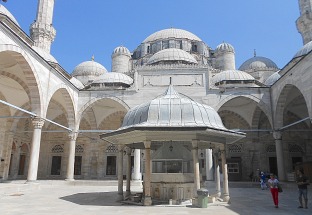 Şehzade Cami
Şehzade Cami
Despite its great beauty the Şehzade Cami is a reminder of great loss which came in the shape of the unexpected death from smallpox of Şehzade Mehmed (Crown Prince Mehmed), the much-loved eldest son of Sultan Süleyman the Magnificent, in 1543.
This was the first of the great complexes Sinan designed for the city and clearly reflects the lessons he had drawn from the older Beyazıt Cami nearby not only in the lovely red and white patterns in the lunettes above the windows of the courtyard but also in the patterns carved into the two minarets.
The walled grounds of the mosque contain many tombs rather like the Muradiye in Bursa. Besides Şehzade Mehmed, his brother Cihangir and the grand viziers Rüstem Paşa and İbrahim Paşa are buried here. Although most of them have been restored recently they are not currently open to the public. You can at least peer through the windows of the rectangular tomb (1614) of the statesman, Destari Mustafa Paşa, right beside the southern entrance to the grounds from Şehzadebaşı Caddesi. Its walls are papered with fine İznik tiles.
Şehzade was once part of a big social complex , much of which still survives albeit split up by a road so that it isn’t always obvious. On the Golden Horn-facing side of the grounds sits the medrese as well as the dershane (lecture theatre) that opens off it. To see the old kervansaray you have to go out into the street and walk down Dedeefendi Caddesi; facing it across the street are the restored imaret (soup kitchen) that now serves as a special events venue, and the old sibyen mektep (primary school).
Around Şehzadebaşı
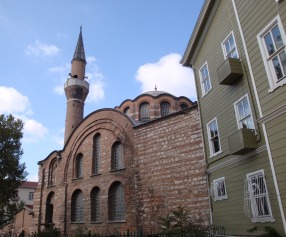 Kalenderhane CamiIf you approach Şehzadebaşı from Beyazıt Meydanı you will emerge on Vezneciler Caddesi with the early 17th-century Kuyucu Murad Paşa Medresesi on the left-hand side. A short walk west will bring you to a major road junction. If you turn right along 16 Mart Şehitler Caddesi you will come, on the left, to the impressive Kalenderhane Cami that started life as the brick-built 12th-century Byzantine Church of Theotokas Kyriotissa. It stands in a dip with a small garden just in front of the Aqueduct of Valens. Despite the rubbish piled up here you can just about make out traces of an earlier church on the site as well as slight traces of a Roman bath.
Kalenderhane CamiIf you approach Şehzadebaşı from Beyazıt Meydanı you will emerge on Vezneciler Caddesi with the early 17th-century Kuyucu Murad Paşa Medresesi on the left-hand side. A short walk west will bring you to a major road junction. If you turn right along 16 Mart Şehitler Caddesi you will come, on the left, to the impressive Kalenderhane Cami that started life as the brick-built 12th-century Byzantine Church of Theotokas Kyriotissa. It stands in a dip with a small garden just in front of the Aqueduct of Valens. Despite the rubbish piled up here you can just about make out traces of an earlier church on the site as well as slight traces of a Roman bath.
It’s a great shame that you can no longer see the greatest treasures of the church which were a 7th-century mosaic showing the Presentation of the Christ Child in the Temple; and a cycle of frescoes depicting the life of St Francis of Assisi believed to have been applied to the wall in 1250 during the half-century of Latin rule that followed the arrival of the Fourth Crusade in Constantinople in 1204. All were removed to the İstanbul Archaeological Museum but are not generally on display.
Immediately after the Conquest in 1453 the church was handed to the Kalendar dervishes for use as a lodge at which time a single minaret was added to the exterior.
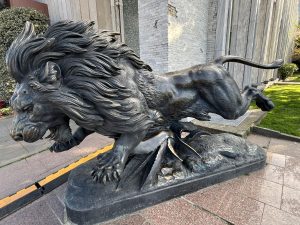
If you walk through the arches of the Aqueduct you will come to the Süleymaniye neighbourhood. Alternatively, return to Vezneciler Caddesi and turn right onto Şehzadebaşi Caddesi. Opposite a pair of large hotels you will see a string of small shops and restaurants built into rather ramshackle old buildings that look likely to disappear any day soon.
The shops stand on the site of the Direklerarası arcaded bazaar where Ramazan festivities were once held. This was once part of the Damad İbrahim Paşa complex, much of which is still standing. The name Direklerarası (“between the columns” in Turkish) commemorated a double arcade of 82 shops fronted by porticoes that had been added to it in 1728-29 to provide funds for its maintenance, the design probably a conscious attempt to recall the lost colonnaded streets of Byzantium. Both columns and arcades fell victim to urban “improvements” between 1864 and 1957.
Direklerarası slowly evolved into the main centre for evening entertainment during Ramazan. One huge shoeshop turns out to be housed inside one of the old cinemas that then took root here before the entertainment centre shifted its focus north to Beyoğlu.
At the end of the line of shops is a small graveyard beside a lovely corner sebil (water distribution point). Both are part of the Damat İbrahim Paşa complex, home to the East Turkestan Foundation. Originally it consisted of a medrese made up of a library and lecture theatre set around a central courtyard but the lecture theatre has since been converted into a mosque. Damad İbrahim Paşa was a dedicated builder responsible for such İstanbul landmarks as the Kızkulesi (Maiden’s Tower) and the glorious fountain in Ortaköy Meydanı. None of that saved him from execution during the Patrona Halil revolt against Sultan Ahmed III in 1730. He is buried in the graveyard beside the sebil with a modesty that belies his once great power.
Dedeefendi Caddesi beside the mosque leads down to the Vefa district and its famous boza shop. Before walking along Şehzadebaşı Caddesi to the entrance to the great Şehzadebaşı Cami, pauss to glance at the stone column embedded in the wall on the corner. It was placed there by Sinan to mark what he believed to be the precise centre of the city in the 16th century.
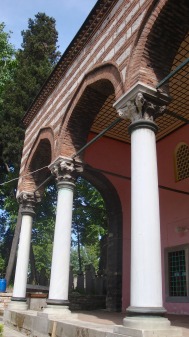 Burmalı CamiA small park separates the mosque from busy Atatürk Bulvarı. If you turn right here and skirt the walls of the Şehzade Cami you will come to the small Burmalı Cami (Twisted Mosque), its minaret decorated with twisted ridges. A small portico incorporates Byzantine capitals, conceivably taken from the site of the lost church of Hagia Polyeuktos just across the way. It dates back to 1540 when it was built for an Egyptian judge.
Burmalı CamiA small park separates the mosque from busy Atatürk Bulvarı. If you turn right here and skirt the walls of the Şehzade Cami you will come to the small Burmalı Cami (Twisted Mosque), its minaret decorated with twisted ridges. A small portico incorporates Byzantine capitals, conceivably taken from the site of the lost church of Hagia Polyeuktos just across the way. It dates back to 1540 when it was built for an Egyptian judge.
On the far side of Şehzadebaşı Caddesi beside Atatürk Bulvarı is the modern building that houses the İstanbul Büyükşehir Belediyesi (İBB), the authority with overall responsibility for the administration of the city. It was designed in 1953 by the architect Nevzat Erol (? – 2003). Busts in front of it commemorate old mayors of the city running back to Hızır Bey who held the post from 1453 to 1458. But most people will probably be more struck by the bizarre transparent box containing waxwork figures readying themselves for prayer, a memorial to the failed coup attempt of 2016. Look closely at the iron lion nearby (one of a set of animal sculptures manufactured in France for Sultan Abdülaziz in 1864 ) and you’ll see a bullet-hole, a more telling reminder of what happened on the night of 15 July.
Immediately behind the İBB building the small red-brick Ankaravi Mehmed Efendi Medresesi dating back to 1707 goes almost entirely overlooked despite housing the Research Association for the Turkic World. 
At the junction beside the İBB building you can walk south to Aksaray, north to Unkapanı and the Golden Horn, or west to Fatih.
Sleeping
Celal Ağa Konağı. Tel: 0212-519 0909
Transport info
You can easily reach Şehzadebaşı by taking the Metro to Vezneciler or by walking across Beyazıt Meydanı and out the other side.
Nearby areas
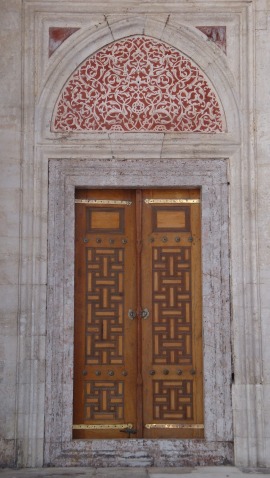 Beauty of Şehzade Cami
Beauty of Şehzade Cami


